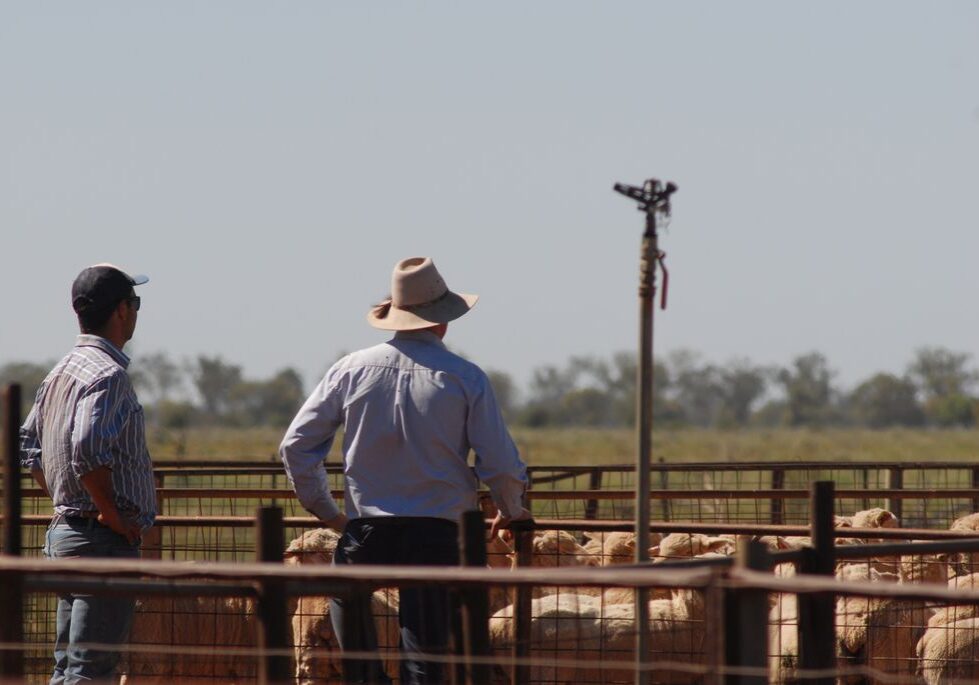Overwhelmed by copy and want to learn how you can nail it to drive sales in your agricultural business?
Marcella Allison is an award winning top direct response copywriter with over 25 years experience under her belt. She’s also founder of Titanides, which supports women in the entrepreneurial space.
Wright Social founder, Heidi Wright, had a chat with Marcella, about the fundamentals for creating compelling copy, and for capturing that perfect voice.
Heidi Wright Okay, Marcella, it’s so fantastic to have you join us here in the Get Customers for your Ag Business with Social Media Facebook group. How have you been? Tell us what’s been on your plate the last couple of weeks because you are all about copywriting.
Marcella Allison It has been a very busy timeframe. We’ve been doing a lot of teaching and training in our Titanides group, which is mainly female copywriters, marketers, entrepreneurs. So, we had a great copy lesson today on how to take your copy to the next level, adding more urgency, more intensity. So, we’ve been doing a lot of trainings, we’ve got job postings, I mean every day is a new day. I’m sure it is the same way in your group, right? Where people pop in, say, “hey, I’ve got this thing going on. Anybody got any support?”. You know, especially with all of us going through COVID right now, I think having these kinds of communities, like you’ve built, like we’ve built in our industries, has just been critical, more so than ever, I really think.
Heidi Wright Absolutely. I think community is so important, particularly as you say, when we’re going through instances like COVID, we’re very lucky to have each other. We’re very lucky to be able to connect across the world too, which is where you come in, because you’re joining us from Illinois, is that correct?
Marcella Allison I’m actually in Ohio now but my family farm is in Illinois.
Heidi Wright Yeah, excellent. And they do corn and soybean?
Marcella Allison Corn and soybeans, right there in the Corn Belt.
Heidi Wright Fantastic. And, Diane, thank you for joining us. Hello, Dee, feel free to ask any comments in the chat if you’d like Dee, or unmute and ask away as you need to.
So, Marcella, we’re here to talk about creating targeted copy that delivers proven sales results. And it’s really exciting to talk to you because you have helped numerous businesses make a big investment with the copy. And that’s translated into sales for them. So, I’m really keen to break that down and look at what are the fundamentals that you’ve learned from your experience when it comes to creating that compelling copy that converts customers.
And then I’d also like to talk to you about capturing the voice of your customer. So quite often, we are writing our own content, we are the personality, our audience gets to know us, and we feel very close to our audience. And you in your scenario, you’re working with EG, your social media manager, yet you are the voice for your brand. So, it’d be great to get some insight into how does EG communicate with you to add value and do that polish, while still trying to stay true to your brand?
So, let’s jump into number one. First, tell us about your formula for creating that copy that converts and generates those proven sale results.
Marcella Allison So, I think one thing I want to say is that the difference between direct response and say Madison Avenue is for Madison Avenue, think of the Cheetos ad at the Super Bowl. Does anybody have any idea how many bags of Cheetos were sold after the tiger went off across the screen in the Superbowl? No, right? There’s no way to measure that unless there was like a mad rush on local stores buying Cheetos, right? In direct response, every action has to be measurable, and it doesn’t matter if it’s a sale. Is it a click? Did they watch something? Did they download something? Did they like something? You just want to measure what did they engage with?
So, I focus on writing copy that can be measured. And like I said, it doesn’t have to be a sale. But I can tell you how many people watched it, clicked it, liked it, viewed it, and that’s critical because that’s the only way you know if your message is working or not. And nobody’s perfect right out of the gate. So, I would say one of my first pieces of advice is everybody is going to learn through trial and error. Because what works selling something today might not work, Lord, in the world that we live in, three days from now, let alone three months from now. So, get over the idea that there is one formula, one trick, one way that you’re supposed to do this and that it’s going to work if you just cross all the boxes. That’s not how it works, you have to be willing to experiment.
So, another fundamental principle of direct response is test, retest, retest, retest, retest. So, try three posts, try four posts, try one with a picture of the dog. You are going to have to test your way into what works for you, and you will never arrive at the perfect answer, you’ll arrive at something that works for a while. But you always want to be testing, because you’ll never know if there’s something better if you’re not testing. And one of the blessings of the world we live in now that didn’t exist when I started 30 years ago, is that it is very inexpensive in many ways to test online. I started out when everything I tested had to be mailed and came to your mailbox, not your inbox, your snail mailbox, and the cost of that postage was massive. And the cost of failure was expensive. And even then, we would always do a split test, at least. But the beauty of being online is we can test a million things, I mean, not a million, but you know what I mean. So, you want multiple ways. Anytime you’re writing copy, you’re going to want to test multiple versions. So that’s another fundamental principle.
And then I’ll give you just a few simple writing rules that many people either underestimate or ignore at their peril. So, the first is write in conversational tone. So, I know you’ve gotten a lot of business-to-business folks here, and I get that every industry has jargon, right? If I use combine when talking to an Illinois farmer, it’s meaning is a whole lot different than if I use the word combine talking to an NFL player, right? They’re like, “Oh, you mean the combines?” I’m like, “No, I mean, the field”. Totally different lingo. So, I get that you have a language that’s unique. But you don’t want to talk all jargon. Think about how you feel when you read all jargon, you snore, right? You don’t want your prospect to do that. Think about when you have to read something so complicated – I mean, how many times have you read an owner’s manual for a piece of foreign machinery, and you thought you wanted to shoot yourself before you were done? So, write in a conversational tone, it’s not insulting, it’s easy for someone to read it. That lowers the amount of effort, that means they’ll read more, that means they’ll go further with you.
And related to that is check your grade level. And we have a rule that nothing should go above seventh grade. And you can use it, it’s a very simple feature on Microsoft Word. There’s the Hemingway app, there’s a whole bunch of apps that will check your grade level. It is not that you’re writing dumb copy, it’s that you’re writing easy to understand copy, and it has more to do with the structure than your vocabulary. But again, there’s a classic rule, if a 10-cent word will do, don’t use a $10,000 word. Again, it’s harder for your prospect to lean into that. So, write in conversational tone, try to keep your grade level around seventh grade. Ask yourself, “What’s in it for them?”. EG and I were talking about this earlier, when it relates to social media that too often, especially in this Instagram influencer world, it’s all about the person posting, instead of being about the person consuming social media. What’s in it for them? What are you offering them? What are you bringing to them? Why should they pay attention to you?
Have someone else read your copy. This is really simple. It doesn’t have to be an expert. In fact, a friend of mine used to say the best person to read his copy was his 12-year-old son. And all he would say is “Is it confusing, unbelievable or boring?”. Those are really easy to fix. Confusing means you didn’t explain it well enough, unbelievable means you need to add more facts. If I say this piece of machinery will save you 30 hours a week, you better tell me in facts – tested by 400 farmers on the Illinois prairie they discovered that… Or, XYZ study at PDQ University found that farmers who use this… – whatever your thing is, you need a proof element for if they say “I didn’t believe you”. And boring means you need to remember that your fundamental job is to be especially in business to consumer copy. You need to remember that you must entertain. Think of how many advertising messages come at you every day, right? You need to be the one that’s fun and engaging to read. I used to have all of my writers sign up for The Hustle. It’s a newsletter, a free e-newsletter. They have a technology version that goes out each week. It’s entertaining, it’s fun, it’s snappy, it’s got great language, I’m like, “that’s how you want to write”. And The Hustle goes to a bunch of educated investors and it’s newsworthy. So, they’re not sending it to first graders, but they’re making it entertaining, and so people lean into that. So, remember that that’s part of your job.
And then here’s a final one, which is sort of interesting. So, business to consumer, and I would argue even business to business, remember that you must be entertaining and engaging. I’m not saying you have to print a three-ring circus, but you have to be entertaining and engaging. And in business to business, this is something a good friend of mine taught me who used to write for the HR market for people in human resources, who had to sell a program for a big company. So, these are usually big-ticket programs, and they’d have to sell it to the CEO to get sign off. So, what she taught me is when you’re writing, think about who else must sign off on that decision.
So, in finance, we say everyone writes to the husband, forgetting the wife often has veto power, right? Or at least give that person the argument they need to make to the decision maker. So, if you’re in a B2B space, and you’re communicating with the person who’s not the signatory, who’s not going to write you the cheque, but who is going to be your advocate, to argue for the purchase, make sure you literally spell out for them everything they need to tell the decision maker simply and clearly. Because that’s going to make that sale happen like a grease shoot automatically.
Heidi Wright I think that’s a really important point there Marcella, because it’s something that we often forget, there’s not always just the one persona that we’re talking to. And depending on the goal that we want to achieve from this copy, we’ve got to consider who that decision maker is, and who that influencer is. So, I think that’s a really good point. And addressing objections early, having that opportunity to understand what different people are thinking through when they’re looking at this decision, some people might be thinking, “what’s the opportunity?”, whereas another person might be thinking “what’s the risk?” and being able to identify that and talk to that, so by the time they’re at sign off, we’ve already addressed those early objections is
Marcella Allison So important, so important.
Heidi Wright Well, this is great, you’ve given some really good points there. Is there anything else in terms of the rules that we need to cover in terms of the fundamentals of developing that really good, strong copy?
Marcella Allison I think those are just really key ones that people forget, right? So, we could go into much higher-level strategies. But I cannot tell you the number of times when I’m trying to read a piece of copy, and I’m having to work, I’m having to work at it. And you never want your prospect to have to work because they don’t owe you their attention. In fact, on the training that we did earlier today, we pointed that out. They don’t owe you the next paragraph, they don’t owe you reading beyond the headline. You have to earn every word they read, you have to earn it by being easy to understand, by adding value, by remembering to point out what’s in it for them. And if you’re not willing to do that work, they’re not like a graduate student who has to read this paper to graduate, they don’t. They are onto something else, right? Whether it’s watching a YouTube video or whatever. They don’t owe you their attention, you must earn it.
Heidi Wright 100%. That’s a really good point there. And I guess that’s where we talk about what makes a good copywriter, versus someone that may be in the office that you’ve given a task to, to go write the copy. I mean, it’s all of these things that make the difference between copy that will convert and copy that will literally be lost on deaf ears or not moving that person any further along their customer journey with you. And when it comes down to it Marcella, it is about that sales funnel that we look at where you’ve got that awareness phase, and then you’ve got that conversion phase, that intent to purchase, and it’s talking to that customer along that journey. So that sales message might come later when they’re ready to buy, which that direct response copy is linked to, but initially, the way we’re warming that audience up is more conversational and educational in that sense.
Marcella Allison So, one thing I would say is, especially for anyone, whether you’re a business owner writing your own copy, or you’re a professional like you are working in the industry, I would say, remember to always be persuading. And if you have anyone who’s worked in direct sales, like someone who literally stood in the shop and had to verbally sell, I think the last combine my grandfather purchased before he passed away was $300,000, so someone had to lead him through that conversation. So, whether you’re doing it one to one in person, or you’re doing it in print, or you’re doing it in video, you have to always be persuading. Even if I’m not persuading you to buy, I’m persuading you to do something, whether it’s finish reading, whether it’s believe something I’m telling you, so you’re always persuading.
I had a very good friend who was one of my first mentors and teachers, and as soon as we started working together, he’s like, “I never want to see an email from you that isn’t written with the intent to persuade me to do something. So, if you want me to move our weekly call to Thursday, you need to write me an email that persuades me why we should do this”. He goes, “let’s say all the family has decided they’re going to go to grandmother’s for Mother’s Day brunch, and you wanted to host it at your house. Write the email, what’s the email to your sister going to say? I know that you want to go to grandma’s. But here’s why… Make your case”.
So, get in the habit of seeing yourself as someone whose job it is to persuade, to persuade, no matter what you’re doing at any step along that funnel. Remember, that’s your role. You’re persuading someone to believe something, to take an action, to take a next step, to agree with you. That’s your job, you’re persuading.
Heidi Wright Which can be very confrontational for some people if they’re not used to playing in that marketing role?
Marcella Allison You know, it’s funny, because in the beginning, I remember one of the very first projects I worked on was a book about cancer therapies, alternative cancer therapies. And my chief, my copy chief, was pushing me harder and harder and harder. And I was like, “Oh, I don’t know, I’m not comfortable”. And he said, “Okay, what happens if they don’t buy the book, and they don’t get this information? What is the consequence for them if they don’t take this action that you believe in with all your heart is going to help them?” and I’m like, “Well, they might be really sick after chemo, because they don’t know that there’s this herb they could take that would help with nausea. They might suffer needlessly”. You have to think, “What is that consequence for your customer?”. Tap into that.
And when you’re persuading, it’s the same thing. We teach people who work in the nonprofit world. So, I’ve also written copy for the nonprofit world, and people would say, “I can’t ask for money”. And I would say, “do you think the foster children in this house deserve to eat tonight?”. “Well, yes.” “Well, what happens if nobody makes a donation, and there’s no money for food for these 30 foster kids? Who will feed them?”. And then you could see it start to click, “Oh, I’m not asking for money from me. I’m asking to feed these children because I know the consequence”. So again, you’re not asking your customer for money, you’re persuading your customer that you can give them the outcome you know they desperately need and want, because they are suffering from a need that you can solve. And focus on that. And that will help you lead into generosity and lead into helping, and that shifts the conversation.
Heidi Wright Fantastic. Awesome, Marcella. Let’s shift now working with a social media agency to get your message and voice and tone right. What have you experienced here? Luckily, we have EG on your social media.
Marcella Allison So, this is EG, who’s our new social media manager. So, I can tell you that I tried this on my own for six years. So, I have just now hired EG and in two months, we’ve more than doubled our engagement. What I will tell you is one, I didn’t have a strategy. So, one thing EG said was “We’ve got to be clear about the strategy. What is the purpose of this? What are we? What are the goals? What do we want to achieve? How are we going to measure it?”. Because EG, you can jump in here, but EG is like, “I’m not just posting pictures of happy cats for the sake of posting pictures of happy cats, like, what is the purpose behind this? And we’re not going to do this shit randomly, pardon my French, we’re going to have a schedule, a time, a purpose behind each piece that we engage with”. So that was huge, to have someone map out your strategy, like an agency is going to do.
And in terms of going back and forth, and EG I want to hear your version of this, for me, I generate a lot of content in other places, which I’m sure almost everyone in your group does. So, I might write an email, I might have made a video. Your group, they might have an ad, they might have once been on the panel, anything. Anything that you already have, especially if you know it worked well, then you can pass that on to someone like EG, they can get to know your voice by watching talks, by reading your emails every day, by getting a sense of how you communicate, but you’ve got to let them in on that. It’s not osmosis, it’s not going to just flow from your brain to theirs. You have to engage them in that. After reading that then she can pull pieces, experts, excerpts, craft. I might have a seven-page email that she breaks down into a single post that can go out. We can also talk that through together. So again, I see too many entrepreneurs think they hired a person. And then they’re like “it’s off my hands”. I’m like, “it doesn’t work that way. This is a collaboration”.
Now, that’s not to say that if I’m on the road, I mean half the time a post shows up for me and I’m like, “Oh, look I posted today, I had no idea”. She’s already scheduled it. But it’s in my voice. It has a picture that she already sourced from our archives. It’s highlighting an event that we have coming up. It’s telling them what action to take. So, I have to keep her in the loop. So, a good example is this call. So, you email me, right? I then make sure she knows I’ve got this schedule, then EG comes back with “Would you like me on?”. “Yes. Okay.” “Are we going to post in the Titanides?”. “Yes. Okay.” She has to know what’s happening, not 10 minutes before I’m about to show up, say “Hey, Oh, I forgot. I’m going to call tonight. Can you post this?”. Because now there’s no purpose, there’s no mission. So EG, do you want to say just a little bit, because I know this is really new for us, but it’s worked really well, about what it’s been like for you to learn to capture my voice? And what have you been able to grab and piece together from your end? How’s it going?
EG I think the big thing really is that the big hesitation with social media in general is everybody says, “I’m boring. I don’t have anything to post. I don’t have anything to say”. And that’s not at all true. You just need somebody to help you take that step back. I mean, you’ve got a lot of content. I haven’t even started with the tip of the iceberg, you just have so much there. And that’s going to be true for everybody. I mean, I’ve even worked with literally musicians that haven’t recorded anything, haven’t released anything, and they have mountains of stuff that they can be posting. The trick is finding that, and you can massage it, you can splinter down the content so that you can apply it to Facebook, you can apply it to Instagram. There’s a lot there, and it’s just knowing how to phrase it. And I know Marcella mentions persuasive copy, everything that you post does not have to require a sale. It might be share your comment, or share the poll, or like the post, it doesn’t actually have to be buy my widget. You’re still persuading, and you’re still helping to solve a problem by getting them to share their problems.
Marcella Allison Oh my god, which is priceless. I mean, literally, what EG is saying is one of the most brilliant uses of social media, to get your customers, to tell you their pain points, in their own words. And then, now, when you’re making the sale to them, you know exactly how to describe that problem and speak to them. They’re literally doing your work for you. And the other thing that EG said that I don’t want you to miss is, everybody has content. It’s not that you’ve written a million emails, it can be, “Oh, I forgot to mention, I gave a talk to the Farm Bureau of Illinois six months ago. Oh, you wanted that?”. It’s any time you’ve used your voice in any way, it could be an interview with a local news station, it could be a write up a magazine did on you. You know where that stuff is, or you have someone who can find it. You have more content, I guarantee you, even if you’re not a writer, you have more content than you know, or realise. And so, you need to provide it to them.
EG It doesn’t even have to be directly related. I mean, there’s ways that you can tie things, we refer to it as the golden thread. I mean, I wrote a sales letter that went from genius invention created by physicists for physicists, and then it ended up being, well, here, you can build your website in four days. But to get from A to B, it connects. So, you can connect anything, it’s like that Six Degrees of Kevin Bacon. Basically, it goes back to the keep them interested, keep them entertained, get them to the point that they want to know what’s going to happen next. How does this tie to that? It’s like there’s a curiosity gap, and you’re connecting the gaps.
Marcella Allison And it’s a great game to play as a writer, which we often do. There’s one where in direct response, it’s a very famous thing called a lumpy package. If you send a package in the mail, and it’s not a flat letter, it has a lump in it, and this works B2B, it works in every industry, people will tend to open it. Why? What’s the lump? They want to know.
Heidi Wright I can imagine. This has been so fantastic. There’s so many good golden nuggets here, just within this conversation. I hope we’ve given it enough structure. I’m sure anyone listening to us has taken so much value. We’ve got D and Lucinda and Phil all on the line. So, thank you so much for joining us. Just one last question to wrap it up. What are three things you’re seeing successful brands do when it comes to driving sales results through copy?
Marcella Allison I think the first thing is we now have the tools to measure just about everything. So, if you’re not measuring, you can’t be improving. So, it goes back to the idea of testing. So, to me, what the most successful brands are doing is measuring, and then testing. So, they’re going to have multiple things out at once, they’re going to be able to see what’s working because they have the tools. For example, EG uses a whole lot of metrics to help us measure social media, we don’t just throw stuff out there. So, as you know, the numbers don’t lie. So, I would say the most successful companies are always testing, they’re measuring so that they know which test is working right.
And I think the other thing is, as we saw especially during the pandemic, they are reinventing, so one of the most dangerous places to be is successful and complacent. And I have seen some of my very successful clients fall into that trap. Some of them pull themselves out of it. For some of them, it was too late, they ended up either dissolving or selling the company because by the time they realised that they had stopped looking for ways to improve and change, and even just keep up, I mean, look at how much the world changes. The sales messages that worked before the pandemic, do not work now because they sound tone deaf. So, I would say that’s my third thing that I see the most successful brands doing are, they are not complacent. They’re always saying, “Okay, we’re doing really well. But one, what’s going to take us out that we don’t see coming? And the other one is, what have we not tested because we’re feeling too safe, and we don’t want to take a risk?”. Those are two edgy things that will make you think differently.
Heidi Wright I love it. Absolutely love it. Before we close up, are there any questions from the people in the room who have joined us?
Marcella Allison We do have a special report, if that’s appropriate for folks. If you would like it, it’s called The Sexist Secret to Succeeding as a Woman in Business. And it is about the gap between male and female entrepreneurs. And it looks at some of the ways that we do things differently and talks about how we can learn from each other. So, it’s for both men and women, EG will pop it in the group for you, which is another great thing that my social media manager does when I’m on an appearance, because I cannot walk and chew gum at the same time. So, if you’re going to be in a setting like this, where you’re being interviewed by someone like Heidi, smart, amazing community, and you’re the guest expert, bring your social media person with you. Ask them, “Hey, would you keep track of comments? Hey, can you make sure I’ve got the links ready?”. Because trust me, if it’s up to me, I will screw it up every single time. So again, use Heidi as a resource. You need to use your resources so that you leverage all those appearances and get the most out of them, because I don’t think of all those things.
Heidi Wright Thank you, guys. It’s been really, really, really wonderful. And so much to take out of this and really appreciate you coming on.
Marcella Allison Okay, let’s see, Lucinda has, I have a lot of content public speaking, and don’t use any of this to post. Help Heidi! Yes, yes. I mean, EG had to teach me to communicate that with her. It’s a partnership. So, you want to tell Heidi, “Here’s what I’ve got”. You want to give her that treasure trove, and you also want to let her know ahead of time anytime that you’re going to be, anywhere that you’re going to have content.
Does simple copy reduce your technical reputation? Oh, my God, I get this question all the time. So, the short answer is no. Simple copy does not mean the cat jumped over the hat. Simple copy means you don’t have a million clauses, so if you have a sentence where someone has to hold the first three things in their head before they get to the end, that takes work. So, one of the things you do is you break sentences up, and you don’t have what I would call a long paragraph run on sentence, where someone has to sort out all the pieces. And you don’t have to call a thing, you know a widget, if it has a technical name, you can use that. It’s more that you want your actions in your verbs, right?
So, the funniest example I ever had a teacher give me was a recall letter on a car, where they really didn’t want you to come back in because it costs them money. So, they made up this thing sudden hood fly up, because there was a problem with the hitch on the hood. So, it was you may experience sudden hood fly up. If you say that a different way, it’s your hood could accidentally come unhooked, it will fly up in front of your windshield, you won’t see, you will die. Okay?
You want to write like that, you want your actions strong and in the verb. And a lot of technical or academic writing will use the nominalisation thing. They turn it into a noun, sudden hood fly up, which is not easy to understand. Think Hemingway. And in fact, the Hemingway app is the one of the very best you can use. Put a piece of technical copy through that. His sentences were short, powerful, action oriented with an actor, right? Someone was doing something. That’s what I mean. That’s what I mean. And you will find that you can get your grade level down just by doing those things. I write about medical conditions that have very long, complicated language around them, and I can still get it down to seventh grade. So, I hope that helps. So, the answer is, no, it doesn’t. It’s not like you’re writing Dr. Seuss, it’s that you’re making it easy to read and understand, which even an engineer appreciates.
Heidi Wright Well, I think that’s a really interesting question from Phil. And I think a lot of people in this field feel a similar way, and “how will my peers interpret what I’ve written when it is so simple and maybe not going down to the detail that needs to go?”. But I think we need to remember who our audience is, we’re not writing for our peers necessarily. We’re writing for our audience, and for them to understand. Well, Marcella, this has been great. EG, thank you, and Dee, Lucinda, Phil, thank you for joining us. I appreciate it.
Marcella Allison Thank you for having us, Heidi. Really, we had a ball, and we really appreciate it. Thank you for giving us a chance to share tonight.
Got questions? Join our FREE Facebook Group for ag-related businesses & professionals to learn and share social media marketing tactics here!





